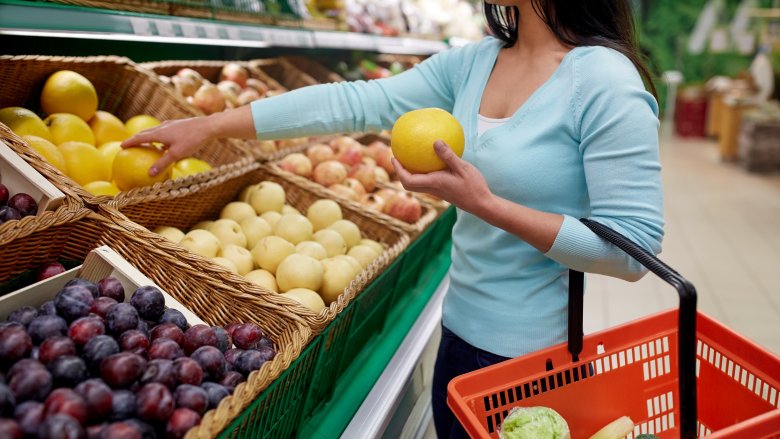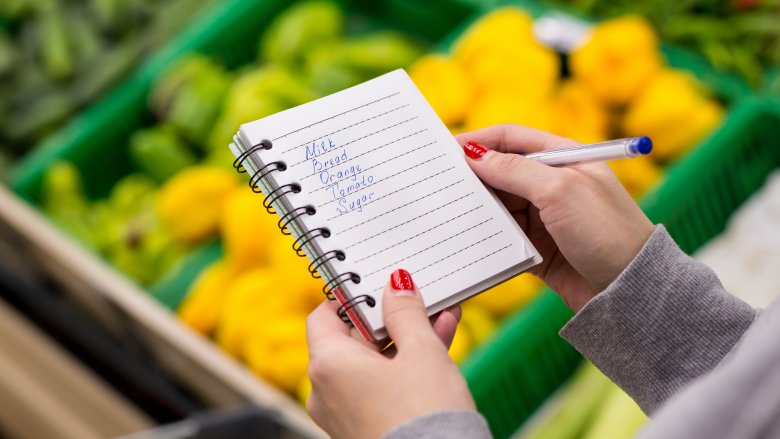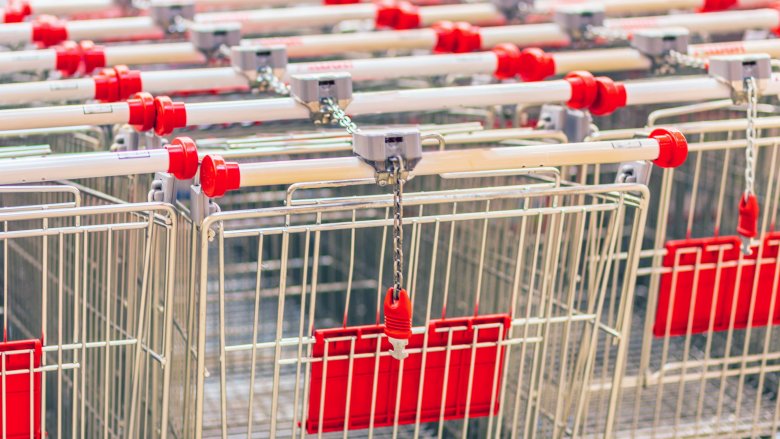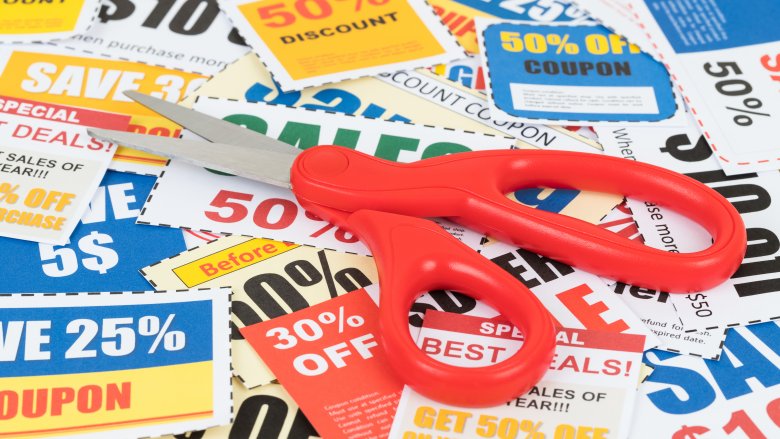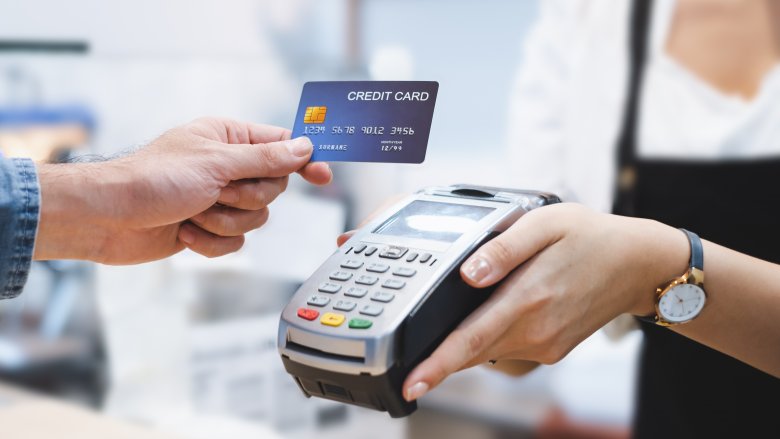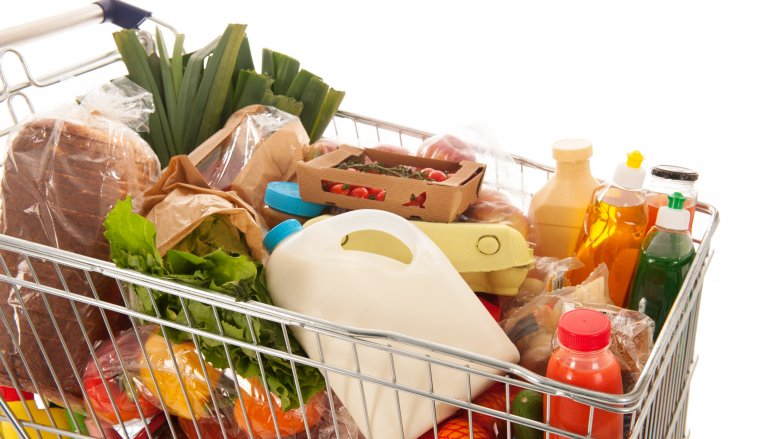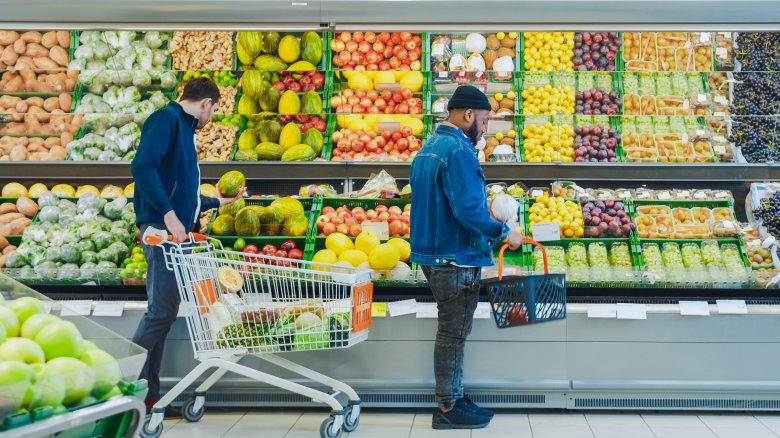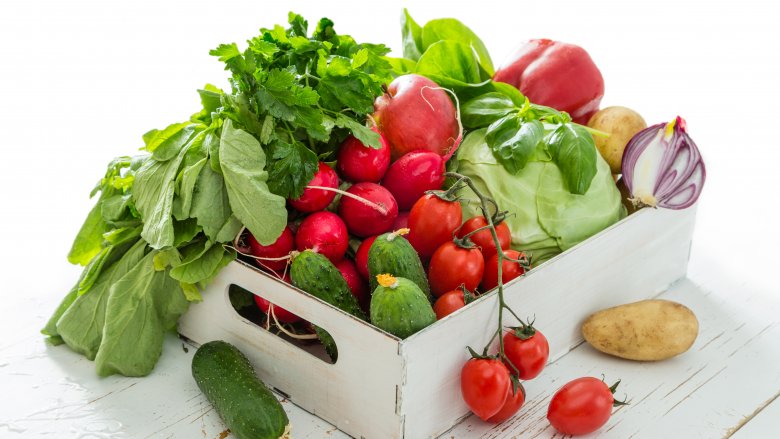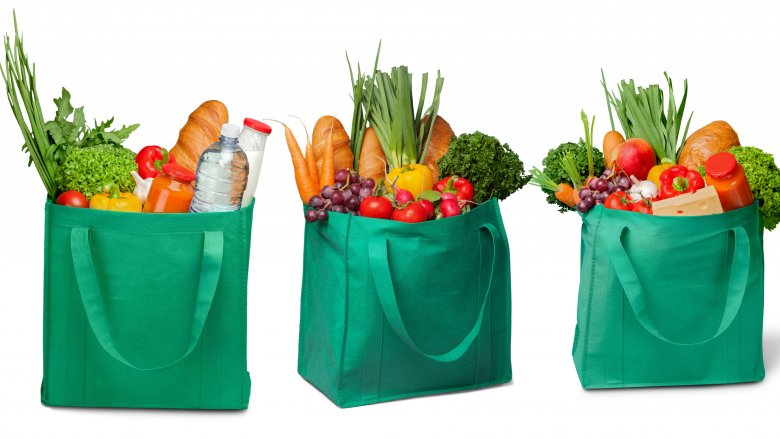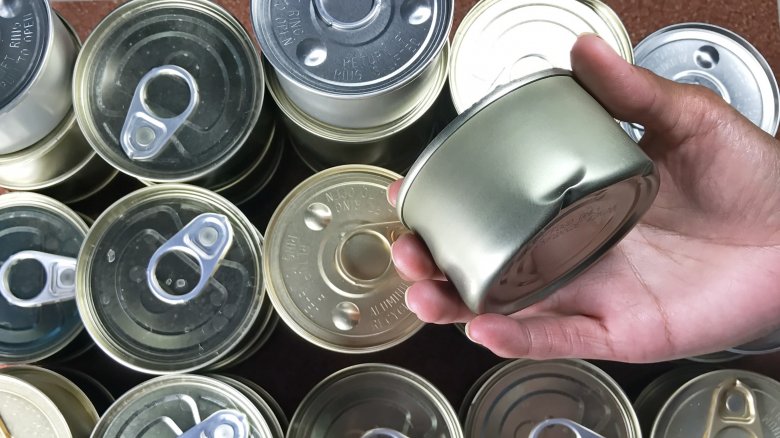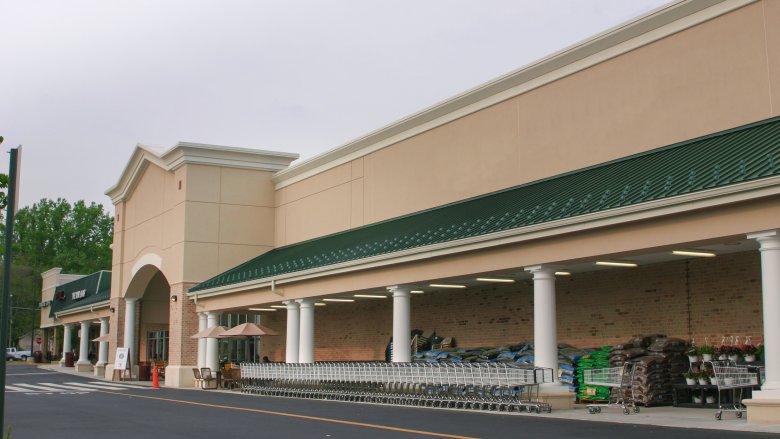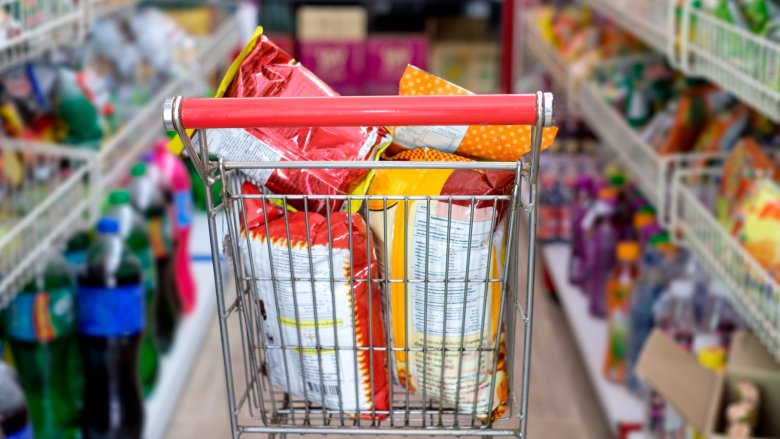Mistakes Everyone Makes At The Grocery Store
The average American family shells out around $150 to $300 a week on groceries, and spends almost 60 hours at the grocery store each year, which means that for a lot of us, it ends up being a considerable part of our lives. But there's a lot that can go wrong at the store, causing shoppers stress, losing them money, and making their weekly chore more of a slog than it needs to be.
Even though grocery shopping may seem intuitive (put food in cart, check out, voila), there are a lot of common mistakes you might be making that are costing you time and money. Thankfully, the fixes are pretty simple — from basics like making a shopping list to the more mathematical challenges (like calculating unit prices to find the best deals), these are some grocery shopping hacks that will help you avoid the simple mistakes that can make shopping feel like such a chore.
You don't make a list
Making a grocery list can make shopping less painful in more than one way. Not only can making a list before you shop save you money, but it can also help you save time.
A list can help you save money because it helps eliminate impulse purchases. When you go to the store without a list, you have to rely on your memory to tell you what you need back at the house, and it's also more tempting to purchase unnecessary items when you don't have a visual way to see that they haven't made the cut.
A list can also save you time. You can keep a magnetized list on the fridge and write down what you need throughout the week, then simply grab and go when it's time to head to the store. You can also organize your list by store section, so that as you walk up and down the aisles, you can grab items that are in the same location at the same time, instead of zigzagging back and forth.
Using a list can also help you avoid purchasing too much of any one item. Double check your pantry and fridge against your list to make sure there's nothing on it that you already have, and don't forget to notate how much of each item on your list you need. This will help prevent over- or underbuying, saving you pantry space and trips to the store.
You forget to check the price per unit
It can be confusing when you're trying to choose between two products but can't tell which one is actually a better value. Is it the large, store-brand jar, or the smaller name-brand jar? Usually you would assume the former is a better deal, but there's one surefire way to compare: the unit price.
Unit pricing is usually shown somewhere on the shelf tag that has the item price on it. You'll often see it listed as price per ounce, pound, liter, or piece. Looking at that price makes it easier to compare two differently sized or branded items — if one jar of salsa is 5 cents per ounce and another is 10 cents per ounce, it's clear which is the better deal, even if the actual size of the product makes it confusing to decide.
Unfortunately, stores aren't required to list the unit pricing in every state, which can make comparison shopping hard, as can labels that don't compare the same unit of measure. Bringing a calculator to the store or using the one on your phone can help, or there are online calculators which let you choose which unit of measurement you want to calculate price by.
You don't sanitize your grocery cart handle
A lot of us get to the grocery store and just want to get in and out as quickly as possible, but there's one thing you need to do before shopping if you want to spare yourself from all the nasty germs floating around: Grab a sanitizing wipe and give your grocery cart handle a quick cleansing.
It may seem paranoid, but the truth is that after being handled by different people all day, those carts can pick up a lot of germs. One Chicago-area study found that 70 percent of shopping carts tested contained traces of E. coli, and another study found that compared to public restrooms, shopping carts had more bacteria, including campylobacter, salmonella, and coliform bacteria (often from fecal matter and contamination from raw meat and produce).
These can cause symptoms like diarrhea, fever, and cramping, and in the case of young children and older adults (or anyone with a compromised immune system) may require hospitalization for treatment.
Thankfully, a quick swipe with a provided sanitary wipe (or one from a travel-sized pack you can bring with you) will help eliminate most of these germs. Just make sure to wash your hands when you get home to get rid of any lingering bacteria.
You forget your coupons
It may seem old-fashioned to clip out coupons from the local paper, magazines, and product packaging, but if you're not taking advantage of the deals and discounts offered with coupons, you're missing out on serious savings.
These days, you can still find coupons in those aforementioned places, but if you don't feel like carefully clipping, sorting, and carrying your paper coupons to the store, you can also get them online and in apps. Google a retailer's name with "coupon," or download a store's app, a cashback app, or a coupon-specific app to see what deals are available. Some retailers and brands will even post coupons on their social media pages, so it might be worth following a few of your favorites so you don't miss out.
Be cautious, however. You don't want to get so caught up in the thrill of couponing that you end up purchasing more than you need, or items that you wouldn't have purchased anyway. You might end up stockpiling items you throw away later, and the hours spent looking for coupons that can be used on items you don't really need is a waste of your time. Instead, look for coupons that can be used toward products and brands you already love and know you'll actually use.
You don't use a rewards credit card
You definitely don't want to go into debt paying for your groceries, but if you think you're responsible enough to remember to pay off a credit card's revolving balance at the end of each month, sparing yourself from interest charges, then credit cards can be a great tool for helping you save money at the grocery store.
Look for a low-interest credit card that offers a higher cash-back rate on grocery purchases (some give back as much as 6 percent, though 1 to 3 percent is more common), or a general cash-back card that works for your other spending needs and can also be used for grocery shopping. If you're very loyal to a particular retailer that has a major credit card (not to be confused with a store charge card, which can't be used elsewhere), that can be a good option too, as retailer-specific cards often give you higher cash-back rewards for shopping at their particular store.
When does this plan not work? If you aren't great at paying off your monthly balances in full, this is one tip you might want to skip. As of 2018, the average American has $5,944 in revolving credit card debt, paying an average of $1,029, per year in interest, which will cancel out any savings you've made.
You don't buy in bulk
Buying in bulk is one way to drive down the costs of your grocery purchases. The reason is that though larger packages of food and household goods can cost more overall, they're often much cheaper by unit price. Grocery stores also often offer discounts for buying multiples of an item, and coupons are also often valid only for purchasing multiple items. You may need to make an initial investment that costs more than your usual grocery bill, but you'll experience savings in the long run.
To smartly purchase bulk items, there are some considerations to make. You don't want to bulk-buy perishable items that you won't actually be able to consume before they go bad, and you don't want to bulk-buy something to get a deal only to discover that you're not fond of the product (so stick to bulk purchasing only products that you know you already like and will use). You also need the space to store these purchases, so take stock of your empty pantry and cupboard space before you shop.
Dry pantry goods like pasta and rice, paper goods like toilet paper and paper towels, and laundry detergent are all safe bets for bulk buying (you can save up to 50 percent on toilet paper when you buy in bulk). If you keep a clear head and only get what you need, this is an easy way to save some money on groceries over time.
You shop the inner aisles first
Finding healthy food among the frozen, dried, processed, and dyed products that line store shelves can be a challenge, but there's an easier way to load your cart with nutritious items than scouring the nutrition facts on the backs of every package you come across: shop the perimeter.
That's because, at most grocery stores, the perimeter is where you'll find fresh produce, meat, and dairy, instead of the more processed foods that line the inner shelves and frozen aisles. Make the most of the perimeter by keeping these produce tips in mind: Deliveries usually occur Monday through Friday, meaning produce is freshest during the week, and you can also usually find the newer produce tucked behind the items at the front of the display. Dig deep for the freshest veggies.
There are some items to avoid on the perimeter, especially as grocery stores start expanding that section of their shops. Sugary treats in the bakery, mayo-laden deli salads, and fatty processed meats come to mind. In general, however, the perimeter is where you'll find the bulk of your fruits, veggies, lean meats, and low-fat dairy products that can help make up a nutritious diet.
You shop out-of-season
People often bemoan the high cost of produce, but there's an easy way to keep your budget in check when purchasing fruits and vegetables: buy what's in season.
There are two reasons. For one, you can often find much better deals on your favorite fruits and vegetables when they're growing abundantly and the supply is outstripping the demand. When these items aren't available domestically, they're often shipped from overseas or from the Southern Hemisphere, and the cost of transport alone can drive those prices up.
Another reason why you should buy produce in season? It's more nutritious. When fruit and vegetables are picked, they start to rapidly lose their nutrients, so if they have to travel a long way to get to your grocery store, they can contain a lot less of the essential vitamins and minerals than their fresh counterparts. In fact, you may even be better off buying frozen instead of fresh if nutrient density is your primary concern and you think the item you need isn't in season.
If you still don't want to buy pre-frozen items, consider buying fresh foods when they are in season and inexpensive, and then freezing them to use throughout the year. You'll get cost savings and preserve the nutritional profile of your ingredients. This can actually be cheaper than just buying the frozen version from the store.
You don't bring your own bags
More than 349 cities, counties, and states have banned single-use plastic bags, or have started taxing or charging for them, which means that you're probably already aware that it's a good idea to keep a reusable bag or two in your car for last-minute shopping trips.
Bringing your own bags to the grocery store can help save you money. It's not much, but a lot of stores will offer you some sort of discount for bringing your own bags, and over a few years of shopping that amount can definitely add up.
It's also just environmentally sound. According to one study, the average family goes through about 1,500 plastic shopping bags a year, and 100 billion plastic bags are sent to landfills in America each year. Just one reusable bag can end up saving more than 22,000 single-use plastic bags over its lifetime, so if you want to do your part for Mother Earth, switching to reusable bags is an easy place to start. Another perk? Think of all the space you'll save when you don't need to reserve an entire cabinet for scrunched up, used plastic bags.
You only buy name brand products
We all know that you can't judge a book by its cover, but did you know that the same can be said for the generic brands at the grocery store? Though a retailer's in-store brand packaging might lack luster, what's inside is often just as high-quality as flashier name brand counterparts, and better yet, these products are usually a lot cheaper.
One shopping comparison pitted name brand against generic products when buying ingredients for specific recipes. In all three cases, the generic products cost less than name-brand. The projected savings were nearly $1,040 per year for just those three recipes, so imagine how much you could save if you buy generic items for all of your household needs.
Even better news is that generic brands are on the upswing. A lot of stores have their own brands now that pay the same care and attention to packaging as the name brands, and 63 percent of consumers agree that generics are getting more innovative in their offerings. By making the switch to store-brand products, you'll be saving money and eating just as well as before.
You stick to one store
We all have a favorite grocery store, but it turns out shopping around can be a better bet in the long run if you're looking to save money.
By shopping around, you can get the best deals on all of the products you need. While your usual grocery store might have the best deals on meat, another store in the area might have better deals on produce, and still another might sell paper goods and cleaning supplies for less. It might take a little extra time to visit these other locations, but the savings can definitely make it worth it.
You also shouldn't fall into the trap of thinking that purchasing everything at a discount store can save you money. You may be able to get certain deals at the local dollar store, but when you start looking at unit prices it might become apparent that the $1 container of spices you're buying is actually a better deal at a traditional grocer.
To remove some of the guesswork here, you can either do some comparison shopping for yourself as research, or use an app that tracks prices at local grocery stores for you.
You shop while you're hungry
It might seem like the best time to shop is while you're hungry. After all, when else are you so attuned to which foods you want to buy? But the opposite is actually true if you're a budget-minded shopper. That's because shopping while hungry can cause you to buy things that you don't actually need and that you won't actually be hungry enough to finish.
Studies have shown that when you're hungry, you're willing to spend more than usual on food. The same is true when you're tired or stressed, when your body produces the hormone ghrelin, the same it makes when hungry.
Other studies have shown that hungry shoppers make less nutritious food choices. In fact, shopping while hungry (or stressed, or tired) can result in adding 23 percent more processed junk foods to your cart than you usually would.
The solution? Have a snack before you head to the store, and try to schedule your shopping trips on the day of the week when you tend to be well-rested and less stressed.
